Ralli Patchwork Quilts
Ralli Patchwork Quilts are one of the most vibrant and culturally significant traditional crafts of Pakistan. Handmade by skilled women artisans, these quilts are known for their colorful patterns, intricate stitching, and deep-rooted cultural symbolism. Ralli quilts are much more than just bedding—they are a powerful expression of heritage, creativity, and community storytelling.
Ralli Patchwork Quilts of Sindh
Originating from Sindh, Pakistan, Ralli patchwork quilts are handcrafted by women across rural villages and towns as part of a thriving cottage industry. Much like the iconic Ajrak textiles, Rallis hold a special place in Sindhi households and are cherished as family heirlooms or presented as precious gifts during weddings, celebrations, and festivals.
Each quilt is a labor of love, often taking weeks or even months to complete. The tradition is typically passed down through generations, with daughters learning the art from their mothers and grandmothers. These quilts are not just functional—they embody stories, memories, and local heritage unique to the region.
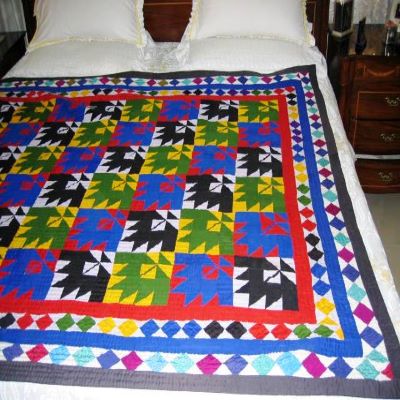 Ralli Geometric Design
Ralli Geometric Design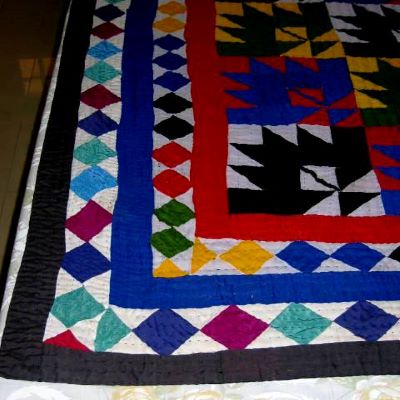 Ralli Geometric Design Border
Ralli Geometric Design Border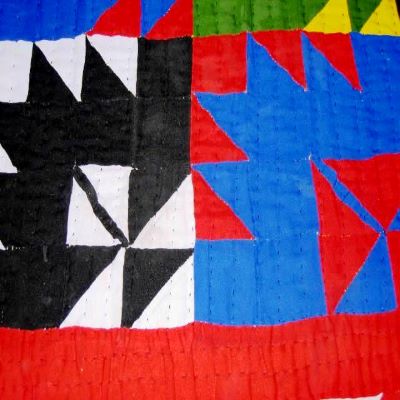 Ralli Geometric Close Up
Ralli Geometric Close UpDesign Techniques: Appliqué, Patchwork, and Embroidery
Ralli quilts are generally classified into three primary design types: appliqué, patchwork, and embroidered quilts. Each design technique reflects a unique artistic style and is influenced by the artisan’s region, tribe, and family traditions.
- Appliqué quilts feature geometric or floral motifs cut from fabric and sewn onto a contrasting base. These are typically created without patterns—passed down through memory and practice, rather than drawn templates.
- Patchwork quilts are formed by stitching together small pieces of colored fabric in structured or freeform patterns. These patterns often depict abstract themes or are inspired by everyday life.
- Embroidered quilts use either full-length fabric or patchwork as the base, which is then adorned with detailed embroidery to create a more luxurious, elaborate appearance.
Geometric Patterns, Vibrant Colors, and Artistic Expression
Ralli patchwork quilts captivate the eye with their mesmerizing geometric patterns and vibrant color combinations. Similar to European and British quilting traditions, these South Asian quilts evoke a universal sense of beauty, symmetry, and warmth.
The artistic appeal of a Ralli lies in its bold contrasts and unique color stories. Sometimes the fabrics are carefully coordinated, while other times they are randomly selected, giving rise to visually striking and organic patterns. These hand-stitched wonders are true examples of textile folk art, and each piece is a one-of-a-kind creation.
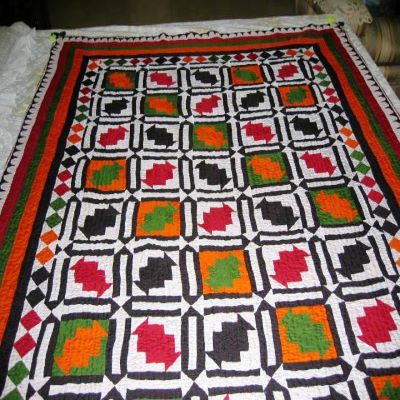 Ralli Pattern
Ralli Pattern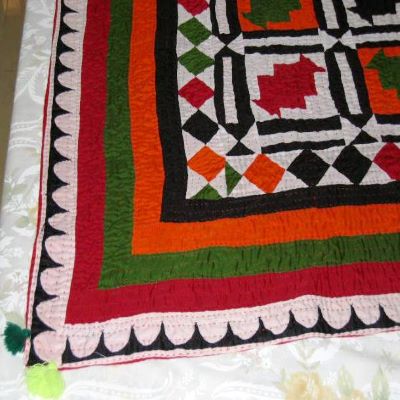 Ralli Pattern Border
Ralli Pattern Border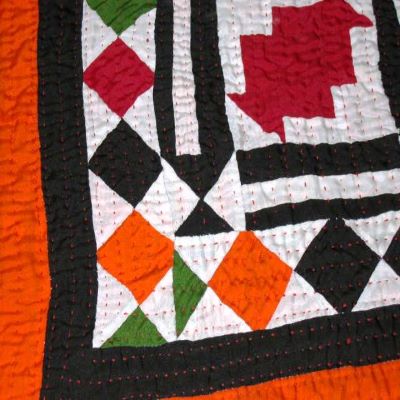 Ralli Border Close up
Ralli Border Close upWomen Empowerment Through Quilting
Most Ralli makers are women from rural Sindh or low-income urban communities. They are supported by women entrepreneurs and small-scale businesses who provide the raw materials and design direction. These partnerships empower women to work from home, preserve cultural traditions, and earn sustainable livelihoods for their families.
Beyond income generation, Ralli-making strengthens community bonds and fosters a sense of pride and independence among the artisans. For those unfamiliar with Sindhi traditions, a Ralli quilt offers a glimpse into the life, thoughts, and creativity of the woman who made it.
Sustainability: Recycling Fabric with Purpose
One of the most eco-conscious aspects of Ralli quilting is its emphasis on fabric recycling. Many quilts are made using leftover fabric scraps or repurposed garments, breathing new life into old materials.
The underside of a Ralli quilt is usually lined with a plain cotton fabric or sometimes with traditional Ajrak, giving the quilt added durability and strength. This sustainable practice not only reduces textile waste but also adds depth and texture to the final product.
Ralli Patchwork Quilts - Sustainability: Recycling Fabric with Purpose
One of the most eco-conscious aspects of Ralli quilting is its emphasis on fabric recycling. Many quilts are made using leftover fabric scraps or repurposed garments, breathing new life into old materials.
The underside of a Ralli quilt is usually lined with a plain cotton fabric or sometimes with traditional Ajrak, giving the quilt added durability and strength. This sustainable practice not only reduces textile waste but also adds depth and texture to the final product.
Applique work is done in patterns of geometric or floral designs with pieces of fabric and these designs are usually learnt from generation to generation. There are no written diagrams but from practice alone these artworks are created. For patchwork, small pieces of colored fabric are cut out and stitched on to each other thereby making a full length, again in patterns that are in the minds of the artisans.
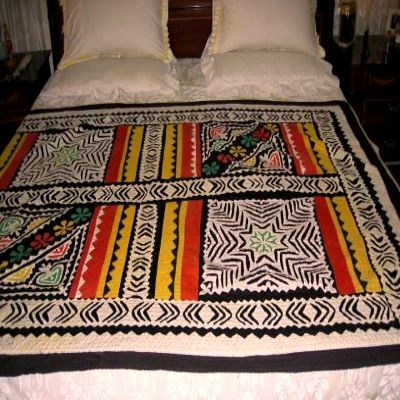 Ralli Multi Pattern
Ralli Multi Pattern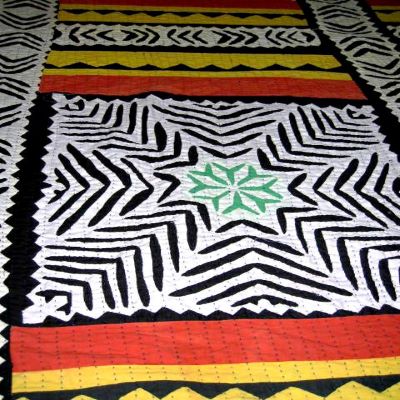 Ralli Multi Pattern-Block 1
Ralli Multi Pattern-Block 1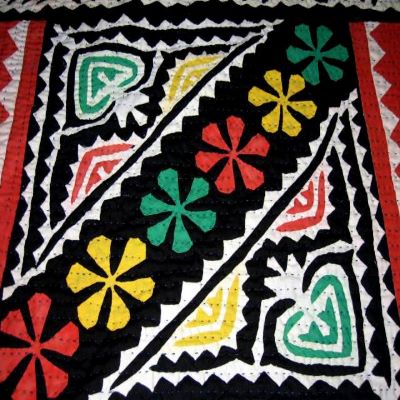 Ralli Multi Pattern-Block 2
Ralli Multi Pattern-Block 2Festive Quilts: Embellishments and Cultural Significance
Ralli quilts are often customized for special occasions, especially for weddings and trousseaux. In these cases, the quilts are embellished with gold and silver thread work, sequins, beads, and sometimes even tassels—often stitched onto satin or velvet fabric to create a rich and festive look.
Each Ralli tells a story. The choice of materials, colors, and motifs can reveal the maker’s background, social status, or the purpose of the quilt. For example:
- An old shawl used as the backing may indicate the artisan belongs to an agricultural family.
- Certain color combinations are associated with specific ethnic groups or tribes.
- The presence of fine embellishments suggests the quilt was made for a major life event.
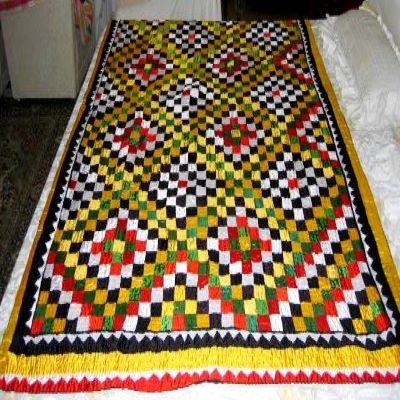 Ralli Satin & Cotton
Ralli Satin & Cotton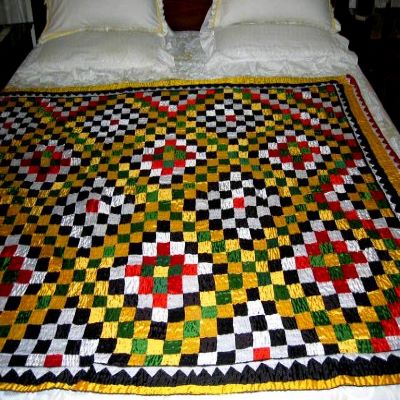 Ralli Satin & Cotton Spread
Ralli Satin & Cotton Spread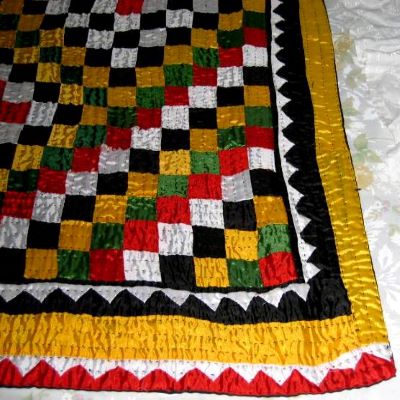 Ralli Satin & Cotton Close Up
Ralli Satin & Cotton Close UpRalli art is a craft that is practiced in various parts of Sindh, Baluchistan, and in India in Gujrat and Rajasthan. In the desert areas, colors are always more vibrant and rich. The story that each ralli tells encompasses its regional communities and folklore.
An interesting article regarding research work Rallis or Rillis on the online store of Indus Crafts is a good read for the background on this craft.
Cross-Border Heritage and Cultural Connection
Though rooted in Sindh, the Ralli craft extends beyond borders. Similar quilting traditions exist in Baluchistan, as well as in other parts of the world. Patchwork quilts are quite popular as the domestic products of EU and UK as well.
Across the Thar Desert and neighboring territories, the use of vibrant colors is a common theme, reflecting the intense hues of local landscapes and festive customs.
These shared traditions highlight the interconnectedness of South Asian culture and underscore how Ralli quilts serve as a bridge between generations, communities, and even nations.
Ralli Patchwork Quilts - A Story Woven in Fabric
Each Ralli is more than a handmade textile—it is a narrative stitched in cloth. Through patterns and patchwork, these quilts speak of folklore, daily life, tribal identity, and women’s creativity. They invite us to appreciate not just the craftsmanship but also the cultural richness and human connection they represent.
For a deeper dive into the historical and artistic background of this craft, the article on the Indus Crafts online store is an excellent resource. It provides detailed research and insight into how Rallis—also referred to as "Rillis"—have evolved as a meaningful folk art tradition.
- Home
- Home Textile of Pakistan
- Ralli Patchwork Quilts


